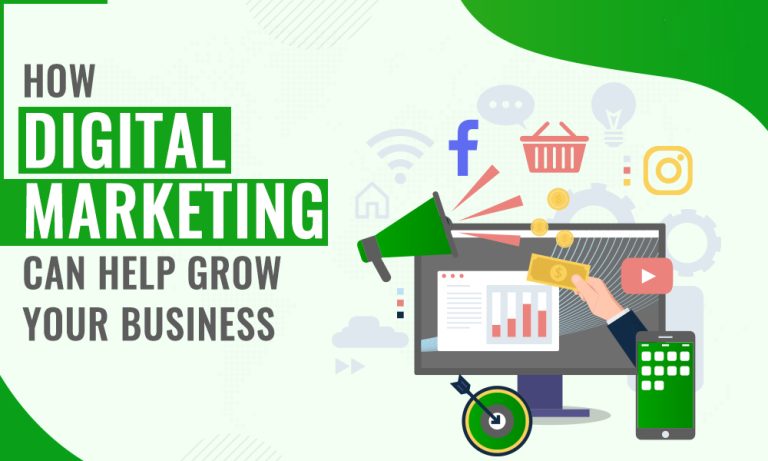What is digital marketing, and how can it help my business?

Digital marketing refers to promoting your brand, products, or services using online channels such as search engines (like Google), social media (like Facebook or Instagram), email, websites, and mobile apps. It helps your business reach a wider audience more cost-effectively than traditional methods. With digital marketing, you can target specific demographics, track real-time performance, and adjust campaigns instantly for better results. Whether you’re a local business or a global brand, digital marketing can increase visibility, attract new customers, and boost revenue through smart, data-driven strategies.
Digital marketing is the promotion of products or services online through various digital channels, such as websites, social media, email, and search engines. It moves beyond simply having an online presence to actively engaging and converting potential customers by leveraging the vast digital landscape. It involves using tactics like advertising, content creation, and engagement to reach and connect with potential customers on the Internet.
How Digital Marketing Can Help Your Business
Digital marketing offers numerous benefits that can significantly help your business thrive in today’s fast-paced digital landscape:
- Increased Brand Visibility and Recognition: Digital marketing helps showcase your offerings and interact with your audience, increasing your brand’s visibility and recognition.
- Access to Specialized Expertise and Technology: Digital marketing agencies provide access to diverse teams of seasoned professionals with specialized skills across various digital marketing domains. They also offer access to premium tools and technology that individual businesses might not afford, such as SEO suites, ad tech, and reporting dashboards, without the direct overhead cost.
- Focus on Core Business: By entrusting digital marketing to experts, businesses can focus on their core operations, knowing their marketing efforts are in capable hands.
- Improved Efficiency and Scalability: Agencies bring structure, support, and speed, acting as a force multiplier for a brand’s internal team. They enable scaling across multiple channels (email, search, social, display, video, affiliates) without stretching internal teams thin. This allows for agility without the growing pains of hiring or reshuffling roles.
- Measurable Results and Optimized ROI: Digital marketing provides a high level of immediacy, allowing for impressions, clicks, and engagements to be generated within hours of launch. Agencies use advanced analytics tools to monitor campaigns, optimize bidding strategies, and ensure a high return on investment (ROI). They translate performance metrics like conversion rates, ROI, and customer acquisition costs into clear next steps, helping your team focus on impactful activities.
- Stay Competitive: By staying at the forefront of digital marketing best practices, businesses can maintain a competitive edge, drawing in valuable organic traffic and achieving sustained online success.
- Risk Mitigation: Marketing agencies ensure campaigns adhere to guidelines, minimizing the potential for costly legal issues and safeguarding your brand’s reputation.
Step-by-Step Roadmap for Digital Marketing Implementation
A successful digital marketing strategy is a long-term, high-level plan designed to achieve specific business goals. It defines objectives, identifies target audiences, and provides a framework for all marketing activities across digital channels. Implementing it effectively involves a structured approach:
Step 1: Define Your Business Goals and Objectives Begin by clearly articulating what you want to achieve. These goals should be SMART: Specific, Measurable, Attainable, Relevant, and Time-bound. They should align with your broader business targets and serve as benchmarks for success. For example, a goal could be to “Increase website traffic by 25% in 6 months” or “Generate 100 marketing-qualified leads per month in Q2”.
Step 2: Conduct Thorough Market Research and Audience Analysis Understanding your target audience is critical. Create detailed buyer personas based on demographics, psychographics, pain points, and online behavior. This helps tailor your marketing efforts effectively. Simultaneously, analyze your competitors to identify market trends, opportunities, and gaps.
Step 3: Audit Your Current Digital Presence Evaluate your existing digital assets, including your website, social media profiles, and content. This audit helps identify strengths, weaknesses, opportunities, and threats (SWOT analysis) and provides a baseline for future efforts. It also involves reviewing historical data on past spending, performance, and channel effectiveness.
Step 4: Develop a Comprehensive Digital Marketing Strategy Based on the insights from the previous steps, a tailored strategy is developed. This involves:
- Channel Selection: Choose the most effective digital channels (e.g., SEO, PPC, social media, content marketing, email) that align with your goals and target audience.
- Content Strategy: Plan the types of content to create (e.g., blog posts, videos, infographics), topics to cover, and frequency of publication.
- Messaging and Brand Voice: Define how your brand will communicate across all platforms.
- Customer Journey Mapping: Outline how potential customers will move from awareness to conversion and retention. Frameworks like RACE (Reach, Act, Convert, Engage) or the Flywheel (Attract, Engage, Delight) can guide this process, ensuring a 360-degree perspective.
Step 5: Allocate Budget and Resources Determine a realistic budget based on the chosen strategies and services. This includes allocating funds for agency fees, ad spend for paid campaigns, and any necessary tools or software. Consider allocating a significant portion (40-60%) of your overall marketing budget to digital efforts. Reserve a portion (typically 10-15%) for testing new channels and optimizing campaigns.
Step 6: Implement Campaigns and Execute Tactics This is the execution phase where the planned strategies are put into action. This includes:
- Optimizing your website for search engines (SEO).
- Creating and distributing valuable content.
- Setting up and managing paid advertising campaigns (PPC).
- Managing social media presence and engagement.
- Launching email marketing sequences.
- Implementing tracking tools like Google Analytics to monitor performance from the outset.
Step 7: Monitor, Analyze, and Optimize Continuously Digital marketing is an iterative process. Establish Key Performance Indicators (KPIs) that directly align with your goals (e.g., conversion rates, cost per lead, customer lifetime value). Regularly review performance data using analytics tools, conduct A/B testing, and be prepared to adjust strategies, reallocate funds, or refine tactics based on insights. This continuous cycle of monitoring and optimization is crucial for maximizing ROI and achieving long-term success.

